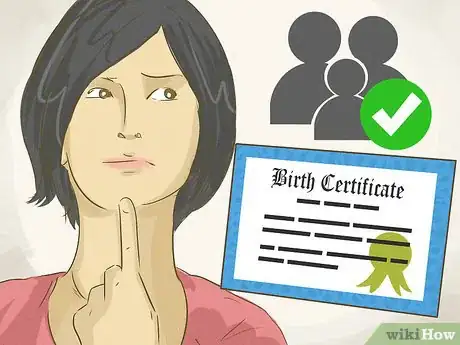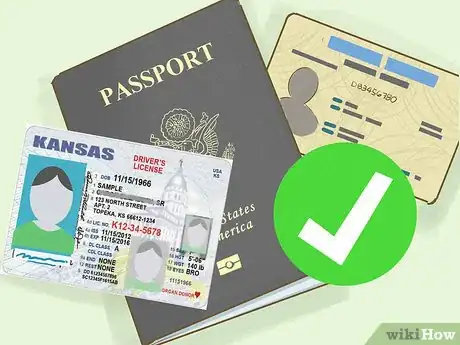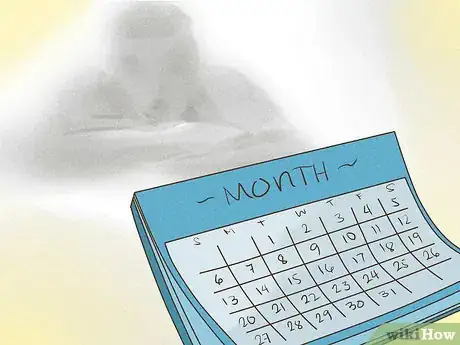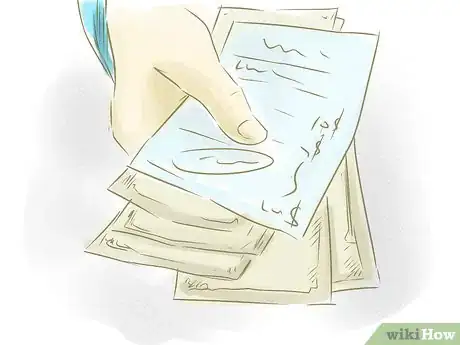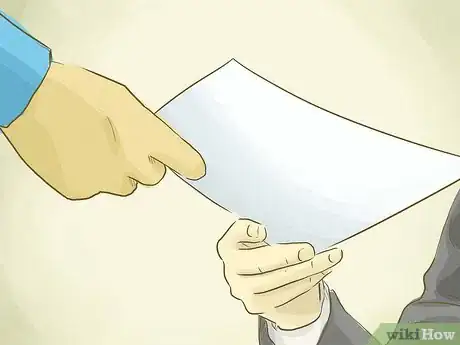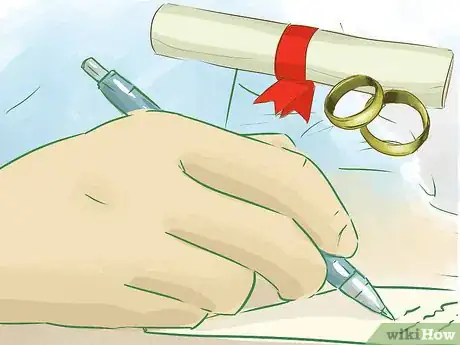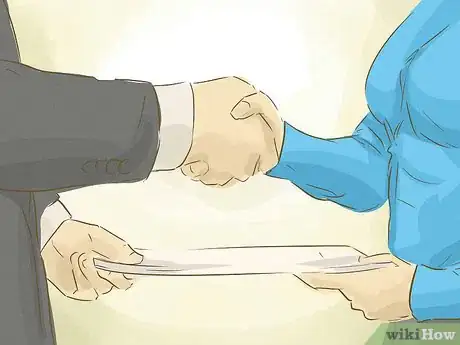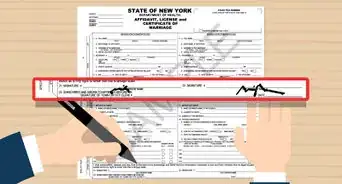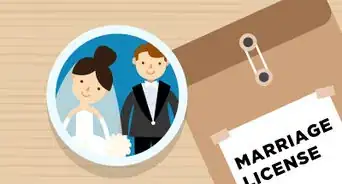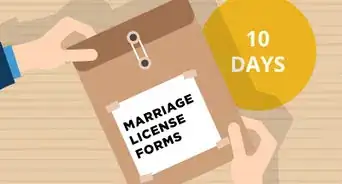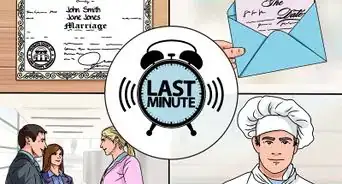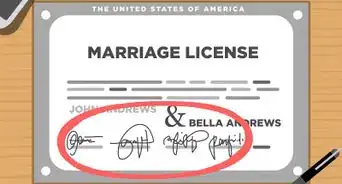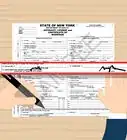This article was co-authored by Clinton M. Sandvick, JD, PhD. Clinton M. Sandvick worked as a civil litigator in California for over 7 years. He received his JD from the University of Wisconsin-Madison in 1998 and his PhD in American History from the University of Oregon in 2013.
There are 26 references cited in this article, which can be found at the bottom of the page.
This article has been viewed 232,303 times.
In the United States, before you take a trip down the aisle, you must first make a pit stop at the courthouse or the vital records office (in the area where you are getting married) to get a marriage license. This license will allow you to be married in a religious or civil ceremony. However, you are not legally married until the completed marriage license (usually signed by the officiant and a witness or two at your ceremony) is sent back to the courthouse or vital records office (and duly recorded).
Marriage license requirements vary depending on where you live and where you plan to be married. Each state has its own laws and regulations, and you must follow the law for the state in which you plan to be married. Use the information in this article to research marriage license requirements and ensure you follow the proper procedure to obtain one successfully.
Steps
Preparing to Apply for a Marriage License
-
1Know who can marry in the United States. In the US, states have specific restrictions on who can and cannot marry. For example, individuals who cannot give informed consent, such as people with severe developmental disabilities, may not be able to marry.[1] Restrictions vary by state, so you must research your state’s requirements. In general, the following restrictions will apply:
- Age. In most states, the legal age to marry is 18. In some states, you may be able to get married if you are younger than 18 by providing parental consent (and, in some cases, the consent of a judge).[2] [3]
- Family relationship. All US states prohibit marriage between ancestors and descendants, such as grandparents and grandchildren, aunts/uncles and nieces/nephews, or parents and children. 20 states currently allow first cousins to get married. 6 additional states will allow first cousins to marry under certain circumstances (e.g., above a certain age or unable to reproduce).[6]
- As of 2015, same-sex marriage is legal in all 50 states and the District of Columbia. [7]
-
2Meet the age requirement of the state where you are marrying. The age at which you can legally marry will vary depending on the state in which you are applying for the marriage license.
- In some counties, you will need to bring your original birth certificate (or a certified copy) as evidence of your age. For example, some Virginia counties require an original birth certificate to apply for a marriage license. However, other counties in the same state will not accept a birth certificate as proof of identity, and do not otherwise require applicants to present one.[8]
- Check with your county or municipal court’s office to make sure that you meet the state’s minimum age requirement and have the appropriate documentation of your age.
- Many states will allow applicants to marry if one or both applicants are under the minimum age with parental consent. In some cases, such as in New York, a family court judge may also need to provide consent.[9] Emancipated minors may also marry without parental consent.
Advertisement -
3Provide proof of identity when you apply for a marriage license. Each applicant must have at least one proof of their identity when applying for a marriage license. In most cases, you will also be required to provide your Social Security Number if you have one. The types of proof required and accepted vary by state and by jurisdiction.
- Government-issued photo IDs, such as passports or driver’s licenses, are generally accepted as proof of identity.
- Many states require your original birth certificate (or a certified copy) and your Social Security card as proof of your identity.
- You and your partner must bring physical copies of these proofs with you when you apply for the marriage license.
- If your original documents are in a foreign language, you must usually provide a certified translation into English, along with the original copy. A certified translation should be signed, dated, and contain a statement that attests to the accuracy of the translation.
-
4Terminate any prior marriage. You cannot get married if you are already married to another person. Some states require proof that your prior marriage has been terminated by death, divorce, or annulment.[10]
- In some states, however, you may certify that you are free to marry by signing a document or providing a notarized statement.
- If either you or your partner were previously married, you will likely need to provide information about those marriages on your application. For example, in the state of New York, you must be able to provide information regarding whether your former spouse is still living, and whether the marriage ended by divorce, annulment or death.[11]
- Bring copies of your divorce decree (sometimes known as a Final Order of Divorce) or other dissolution documents with you when you apply. In some states, such as Pennsylvania, widowed applicants must bring a copy of their deceased spouse’s death certificate.[12]
-
5Decide on your surname. If you wish to change your legal surname once you are married, it’s easiest to do so when you are applying for the marriage license. Once your marriage is completed (also known as “solemnized” or “celebrated”), the name you provide on the license application will become your legal surname.
- Neither partner must change his or her surname, and surnames do not automatically change upon marriage.
- The Social Security Administration will accept marriage documents to legally change your name on Social Security records. If you decide to legally change your surname upon marriage, you must notify Social Security. Social Security cannot “automatically” change your surname.[13]
- Some states have specific restrictions on what surnames may be adopted, and some states have no restrictions at all. Check with your county clerk’s office to determine what restrictions (if any) apply in your state.
-
6Determine if there is a waiting period. Many states have waiting periods before you can obtain your license, or before you can use that license to get married.[14]
- In many states, you can receive your marriage license immediately. Some states, however, have a waiting period between one and six days between when you apply for your license and when you receive it. For example, in Pennsylvania, there is a 72-hour waiting period before you receive your license.[15]
- In some states, there is also a waiting period between the time you receive your marriage license and when you can use it to get legally married. For example, New York has a 24-hour waiting period.[16] [17]
- If you do not observe these waiting periods, your marriage may not be legally valid.
- Waivers may be available under certain circumstances. For example, in New York, you may apply for a judicial waiver of the waiting period if your circumstances require you to get married immediately (e.g., your intended is being deployed in the military)[18]
- If you are in a huge hurry, you can look into getting married in a state where there is no waiting period, or get married in Las Vegas. Clark County, Nevada is widely recognized as probably the easiest place to get legally married in the US.
Applying for your Marriage License
-
1Find the location and address of where you obtain the marriage license. Marriage license locations vary by county, but are often dispensed by the County Clerk. The County Clerk is almost always located in a government building in the county seat.
-
2Fill in the online application first (where applicable). You can apply online in an increasing number of counties. For example, New York City allows you to fill in the application online first. However, you must still bring your documentation to the appropriate office in person to complete your application.[19]
-
3Apply in person. In general, both applicants must appear in person to apply for a marriage license. You should bring all of your required documentation to the office.
- “Proxy” marriage, where only one person must appear, is almost never allowed. In Colorado, you may authorize a third person to act as your proxy if you cannot be present at the wedding solemnization. Your proxy must provide photo ID and a notarized copy of the Marriage Ceremony Proxy Power of Attorney form.
- In California, an applicant who is a member of the Armed Forces, is serving overseas in a conflict, and cannot return home to personally apply for a license, may marry by using an “attorney-in-fact.” Applicants must fill out a power of attorney form, and the attorney-in-fact must appear at the County Clerk’s office with the notarized POA.
- Texas makes certain exceptions for absent applicants in particular circumstances. The absent applicant must complete an affidavit and have it notarized. The third party must present the absent applicant’s photo ID and the notarized affidavit.
- Many counties have unique/different requirements. Read carefully on the county website to make sure you have the correct requirements and paperwork.
-
4Provide your personal information. In addition to providing your documentation, you and your partner will have to provide personal information on the application for a license. This information generally includes:
- Full legal name and any other names used
- Date
- Place of birth
- Parents’ full names and places of birth
- Whether either party has been divorced, and the date of divorce if applicable
- Who will be performing the marriage ceremony
- Social Security Numbers
-
5Pay the fee. The fee to apply for a marriage license varies by state, and in some cases, by county or municipal district. You can expect to pay between $25 and $90. Check with your location to determine what the fee is. Many courts will also post the application fee on their website.
- Some states, such as Oklahoma and Georgia, will reduce the fee for a marriage license if you can provide proof that you have completed pre-marital counseling.[20] [21]
- Call the records clerk in advance to check whether they will accept your preferred method of payment. Many courts accept only credit cards or money orders, while some only accept cash.
- In some places, such as D.C., the marriage license application fee will be waived if you already have a domestic partnership certificate.
-
6Receive your marriage license. If you have done the research as recommended in this article, you will know whether you can expect to receive your marriage license immediately, or whether you will have a waiting period.
Using your Marriage License
-
1Marry in the timeframe dictated by your marriage license. Marriage licenses can expire. In Oklahoma, marriage licenses expire in 10 days. However, most marriage licenses are valid for between 30 and 90 days.[22]
- Know the duration period of your marriage license and marry before it expires. If you do not use your marriage license before it expires, you must re-apply for another license (and pay another fee).
- Some states’ marriage licenses have no expiration date. Georgia, Idaho, Mississippi, New Mexico, and South Carolina, along with the District of Columbia, do not have an expiration period for marriage licenses.[23]
-
2Have an eligible person perform the marriage ceremony. Many states have requirements about who is eligible to perform weddings. Make certain that your officiant is eligible to legally perform weddings in your county and state.
- For example, in Virginia, your officiant (or “celebrant”) must be authorized by a Virginia Circuit Court prior to performing your wedding ceremony. Online ordinations are not recognized by Virginia courts.[24]
- These requirements may also vary by county or jurisdiction. For example, if you wish to get married in any of the five boroughs of New York City, your officiant must register with the City Clerk’s office in Manhattan. This requirement does not apply anywhere else in the state of New York.[25]
- Most states do allow officiants to become ordained online, through organizations such as the Universal Life Church[26] or American Marriage Ministries.[27] Check with your issuing office to make sure this is legal in your state.
- A few states, such as Colorado, allow you to “self-solemnize” your marriage. You may indicate “themselves” on the appropriate line of the marriage certificate form. Check with your court about solemnizing requirements!
-
3Verify the required signatures are on the marriage license after the wedding ceremony. Many states require the spouses, at least one witness, and the eligible officiant to sign the marriage license for it to be valid. Check with your issuing office to determine what signatures must be given.
- Some states, such as Virginia, do not require witnesses.[28]
- Some states require that witnesses be of a certain age. Other states merely require that the witness be able to attest to the fact that s/he witnessed the marriage take place.
-
4Arrange for the license to be filed. In most cases, the person who presides over your ceremony -- known as the “officiant,” “celebrant,” or “solemnizer” -- must sign and return the marriage license to the issuing office. If your officiant is ordained by an online church then use the term "Minister" or "Clergy".
- The office will send you a marriage certificate, which is your proof that the marriage took place. Your marriage is deemed legal once the license is received and filed.
- Many states require the marriage license to be filed within a certain number of days (often 14-15 days). If the marriage license is not filed within that period, the marriage may not be considered legally valid unless a new license is issued and filed.[29]
Warnings
- Do not confuse a marriage license with a marriage certificate. A marriage certificate is for ceremonial use and does not validate a legal marriage.⧼thumbs_response⧽
- Do not plan on your cruise ship captain marrying you. It is a myth that a sea captain, merely by being a sea captain, has authority under U.S. law to conduct a marriage ceremony while at sea that would be valid in any state.[32] Even if the captain is also an ordained religious figure, many states have specific laws prohibiting sea captains from conducting marriages.⧼thumbs_response⧽
References
- ↑ http://www.usmarriagelaws.com/search/united_states/
- ↑ http://www.usmarriagelaws.com/search/united_states/teen_marriage_laws/
- ↑ http://family.findlaw.com/marriage/state-by-state-marriage-age-of-consent-laws.html
- ↑ http://www.usmarriagelaws.com/search/united_states/mississippi/marriage_licenses/
- ↑ http://www.usmarriagelaws.com/search/united_states/nebraska/marriage_licenses/
- ↑ http://www.ncsl.org/research/human-services/state-laws-regarding-marriages-between-first-cousi.aspx
- ↑ https://en.wikipedia.org/wiki/Obergefell_v._Hodges
- ↑ http://www.vsb.org/site/publications/marriage-in-virginia
- ↑ https://www.health.ny.gov/publications/4210/
- ↑ http://definitions.uslegal.com/b/bigamy/
- ↑ https://www.health.ny.gov/publications/4210/
- ↑ http://secureprod.phila.gov/wills/marriagelicense.aspx
- ↑ http://www.socialsecurity.gov/ssnumber/ss5doc.htm
- ↑ http://family.findlaw.com/marriage/marriage-license-requirements.html
- ↑ http://family.findlaw.com/marriage/marriage-license-requirements.html
- ↑ http://family.findlaw.com/marriage/marriage-license-requirements.html
- ↑ https://www.health.ny.gov/publications/4210/
- ↑ https://www.health.ny.gov/publications/4210/
- ↑ https://www.health.ny.gov/publications/4210/
- ↑ http://www.oklahomacounty.org/courtclerk/MarriageLicense.aspx
- ↑ https://athensclarkecounty.com/229/Marriage-Licenses
- ↑ http://family.findlaw.com/marriage/marriage-license-requirements.html
- ↑ http://family.findlaw.com/marriage/marriage-license-requirements.html
- ↑ https://www.vdh.virginia.gov/vital-records/marriage-requirements/
- ↑ http://www.cityclerk.nyc.gov/html/marriage/officiant_reg.shtml
- ↑ http://getordained.org/state-marriage-laws/
- ↑ https://theamm.org/
- ↑ https://www.vdh.virginia.gov/vital-records/marriage-requirements/
- ↑ https://www.mo.gov/home-family/marriage-divorce/
- ↑ http://www.gallatin.mt.gov/Public_Documents/gallatincomt_distclerk/marriagelic
- ↑ http://www.ncsl.org/research/human-services/common-law-marriage.aspx
- ↑ http://www.nytimes.com/2014/03/02/fashion/weddings/a-marriage-at-sea-get-me-rewrite.html?_r=0
About This Article
To get a marriage license, make sure to check your state's laws on how long it will take to get your license after applying for it. Additionally, check to see whether there’s a waiting period after you get your license and before you can marry. Then, get together documents that prove your identity, like your driver’s license, birth certificate, and Social Security card, and apply for your license in person at your local County Clerk’s office. For more information from our Legal reviewer, including how to find someone who can perform your wedding ceremony, read on!

